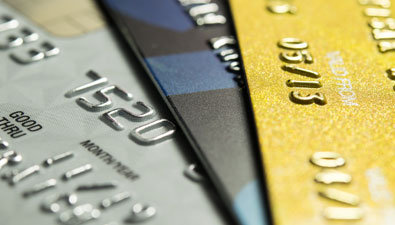How to Get Rid of Credit Card Debt
April 17, 2017

Ways to Work on Getting Rid of Credit Card Debt
Credit cards do have benefits. For some, they’re a simple way to earn points, airline miles, and other incentives with regular monthly spending. They’re also a way to build your credit score over time. But not all of us are disciplined enough or have enough cash flow to pay off 100% of our balances each month. And for those of us who don’t pay off our balances in full, they can really start to add up. In fact, the average credit debt balance held by households in the U.S. hovers around $16,000 today, according to recent Federal Reserve data.
With the typical credit card interest rate hovering around 15.99% and making a minimum payment of $374 per month, it would take 5 years and 4 months to pay that $16,000 balance off. In all, you would pay about 33% in interest – a total of $23,878, or $7,878 more than the original balance. Ouch. To find out how long it would take you to pay off your own credit debt, click here. Fortunately, there are ways to get that debt paid off faster. Here are some options to consider:
Highest Interest First: Paying high interest rates can make it hard to get that debt paid off. That’s why one great way to get your credit card bills down is to tackle the card with the highest interest rate first. If you’re shelling out hundreds of dollars in interest payments each month, you won’t make it too far until you get the principal (the balance you owe) down. To pay down your debt this way, look up the interest rates for your credit cards and organize them by interest rate. Be sure to pay attention to any special low-interest introductory rates and when they expire. Then, make as large a payment as you can on the highest-interest card until it’s paid off, while making a minimum payment on the rest of your cards. Once the first card is finished, go to the next card on the list and do the same.
Lowest Balance First. Another way to take on your credit card debt is to look at the balance of each card, and pay off the card with the lowest balance first. Again, organize your cards – this time by balance owed, and pay as much as possible towards the one with the lowest balance until it’s paid off. Then, put the money you were paying towards the first card towards the next lowest balance card, and so on until all your cards are paid off. This method is great if you need to see results faster to keep motivated.
Which way works best? Every credit situation is different. One way to find the most efficient route to paying off debt, with the least interest and least time spent, is to use a “snowball” debt calculator. Put the details around each card you want to pay off in the calculator, and let it suggest the best route.
Consolidate Your Debt with a Personal Loan. Since interest rates are the hardest barrier to overcome when paying off debt, refinancing that debt at a lower interest rate can have a huge impact on the time it will take to pay things off and the total amount of interest paid.
At Unison, we have options for personal loans that can help. Talk to us to understand whether you qualify! And by the way, by being a member of Unison you’re already on the right track. Credit Union members typically receive lower interest rates for loans and credit cards, according to the National Credit Union Administration.

